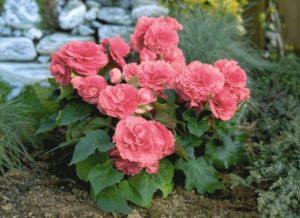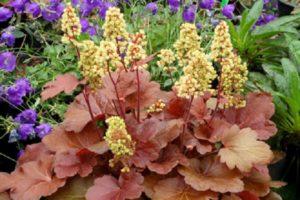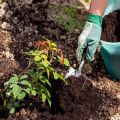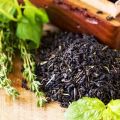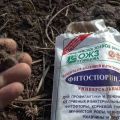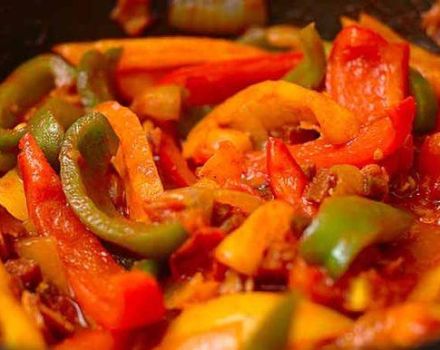Planting and caring for decorative dope, the best varieties and growing rules
To create a landscape landscape, plants are planted that bloom brightly, unusually or for a long time. Decorative datura is a poisonous flower. But the beauty of its buds makes you forget about the health hazards that can occur with careless handling. Breeding it requires careful compliance with safety measures when planting, caring for, storing seeds.
General description and characteristics
Datura is a perennial plant if it grows in regions with warm winters. The weather conditions of the Middle Lane make it possible to grow it as an annual crop.
Herbaceous plants have a powerful root system, from which a straight shoot branches off, branching into 3 stems. The height of the dope under favorable conditions reaches 1.5 meters. Leaves on petioles, 15x10 centimeters in size, dark green, alternate. The flowers are single, simple or double-shaped, reminiscent of miniature gramophone. Corolla color is snow-white, pink, yellow, red, purple. The seeds ripen in a box studded with thorns.
All parts of the dope are poisonous. After swallowing, the person experiences hallucinations, delusions. Long-term inhalation of the scent of blooming datura has a toxic effect on the central nervous system.
Types of datura
According to the botanical classification, the genus Datura belongs to the Solanaceae family. The list of herbaceous dope includes 9 species, in which the flowers open vertically upward or to the side.
Datura Stramonium - common dope
An annual plant found in the wild on forest edges, garbage dumps from the Urals to the Mediterranean Sea. Datura stems are 1.5 meters high. The flowers are white with a strong aroma. In a ripe box - up to 500-800 black grains.

Datura Metel - Datura Indian
Datura habitat - from the Caspian to the Indian Sea. The name is explained by the special attitude to the flower in India. According to the theory of Hinduism, he grew out of the body of Shiva and is considered sacred. The second name is Datura Metel, which means gorgeous dope, because of the graceful huge flowers.
Datura stems are from half a meter to 1.2 meters high. The corolla of the flower is 20 centimeters long. The color is white or purple. Testes in the form of a ball studded with thorns, filled with yellow seeds.
Datura Innoxia - Indian Datura
Homeland of the flower, which has the second name, dope harmless, South and Central America.An annual grows up to 1.5 meters per season if the weather and soil conditions are favorable for it. The color of the flower is white. The fruit is prickly, ovoid. If the stem and leaves are damaged, the plant emits an unpleasant smell of rotten vegetable oil.
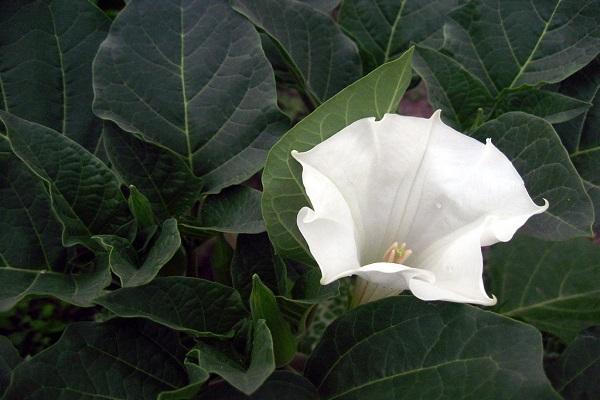
Datura Stramonium var. Tatula
Flower growers appreciate dope for the rich lilac color of blossoming buds with a blue tint.
Datura Stramonium f. Inermis
Datura differs from other species - the absence of thorns on the testes.

Growing features
Datura loves bright sun, but does not tolerate cold drafts. The plant can withstand the heat of summer, subject to abundant watering. Datura feels most comfortable on compost and manure heaps.
Preparing the landing site
For dope, choose a leeward, sunny place. The soil is prepared in autumn from a mixture of loose garden soil, rotted manure and river sand. The ratio is 2: 2: 1. This composition is suitable for sowing seeds, planting seedlings. The thickness of the soil layer should be at least 50-60 centimeters.
Planting material
Datura can be cultivated with seeds, seedlings from seeds or cuttings. When planting seeds in the ground, it is recommended to stimulate their germination. To do this, they are poured with water at a temperature of 45-50 degrees for 20 minutes. Seeds that have settled to the bottom are suitable for sowing.

For seedlings, seeds are sown in March in a container with soil mixture, covered with foil and make sure that the ground is always moist and warm before emergence. With the emergence of shoots, the film is removed, the shoots are transferred to a cool, well-lit place. On the 3rd leaf, a pick is made and the plants are distributed in separate containers.
Planting process
Seeds, seedlings from seeds are planted in May, when a steady heat is established. For planting, holes are prepared at a distance of 1 meter. The seeds are made to deepen up to 8-10 centimeters. Seedlings require a hole corresponding to the volume of the root system. After planting, the soil is poured, slightly compacted and abundantly watered with water.
Plant care
The main care for dope is watering, pruning, and disease control. Loosening the soil and removing weeds is required for the first month until the plant develops branchy shoots covered with large leaves and buds. Shade and aroma inhibit the growth of weeds near datura.
Watering
Datura differs from flower crops in that it needs hard water. If it is absent, the datura is watered 1-2 times over the summer with lime water prepared from 10 grams of dry slaked lime and 10 liters of water. Once a week, 20 grams of complex mineral fertilizer are added to a bucket of water.
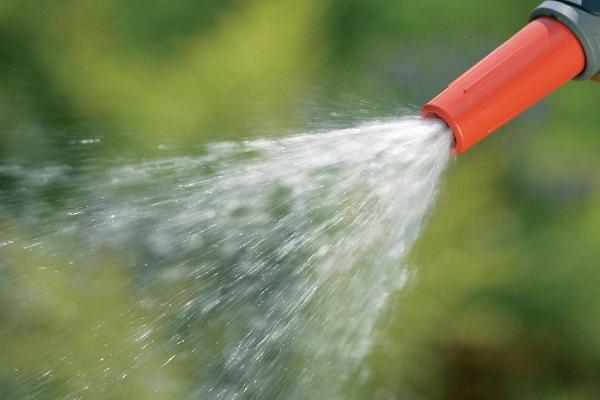
The plant does not tolerate dry soil and sheds buds. The soil must be moistened abundantly. Watering frequency depends on air temperature and amount of precipitation.
Pruning
Fading "gramophone" is removed so that the dope bush looks just as elegant and to stimulate new budding. To obtain seeds, leave a few blossoming very first flowers. Full maturation of the ovaries occurs 60 days after the beginning of flowering.
Pruning is carried out in 2 cases: when grown as a perennial and when stored indoors in the winter. At the end of September, the youngest shoots are left in the perennial, forming the future crown.
Top dressing
Once a week from June to August, 20 grams of complex mineral fertilizer are added to a bucket of water. Organic dressings alternate with mineral dressings if there is not enough humus in the soil where the dope was planted.
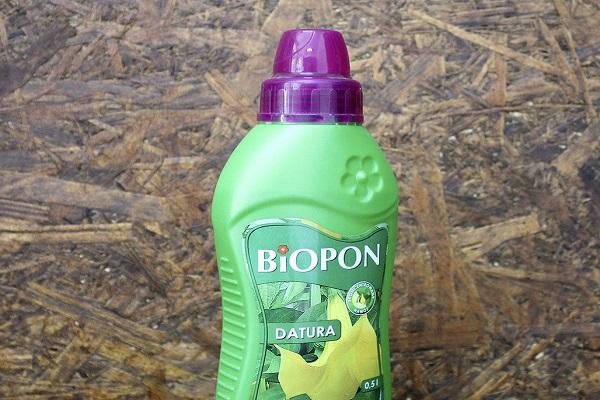
Wintering
In regions with cold winters, annual Datura can be dug up and placed in a spacious pot of formula. Pre-pruning is done with the formation of a crown from young shoots.Plants are placed in a cool room where the temperature does not rise above +15 and does not drop below +8 degrees.
Datura sheds its leaves, but remains viable.
In the spring, after transplanting into the ground, new leaves appear, shoots grow and buds bloom.
Disease and pest control
The appearance of gray fluffy spots on the leaves of the dope means infection of the plant with gray rot, a fungal infection. The development of the disease is favored by the peculiarity of growing datura: the need to keep the soil moist.
To combat gray rot, the bush is treated:
- 1% Bordeaux liquid solution;
- antifungal agents;
- infusion of ash, chalk and copper sulfate.
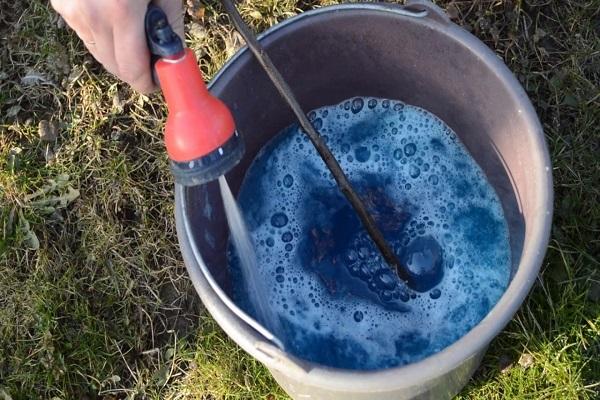
Plant pests are whitefly butterflies and their larvae, false spider mites. The whitefly feeds on plant sap. Caterpillar rejection occurs every 25 days during the summer. Caterpillars not only suck the juice from the leaves, but also secrete a sticky sweet substance on which a sooty fungus parasitizes. To combat insects, systemic insecticides are used, and in the fall they do a deep digging of the soil.
The false spider mite is microscopic in size. The infection can be determined by the dried, brown leaves. As a preventive measure, autumn deep soil processing is necessary. When infected, drugs containing pyrethroids, organophosphorus compounds are used.
How to propagate
For propagation, cuttings are used. Shoots are cut at the end of September. There should be 2-3 internodes on the cut. The lower leaves are removed. You can root in water or soil mixture, with good lighting and a temperature of at least 20 degrees.

In mid-May, rooted cuttings are planted. Seedlings are planted with the ground by the transshipment method. The previously watered plant is removed from the container and transferred to the prepared hole. Sprinkled with earth and watered again.
Examples in landscape design
Datura scent oppresses most flower crops. It is planted next to non-flowering shrubs, spruces, thujas. Bright tonality of colors looks more expressive against the background of dense greenery.
Datura is planted in separate flower beds on the banks of artificial reservoirs, streams or next to perennials that bloom before or after the flowering of datura.
